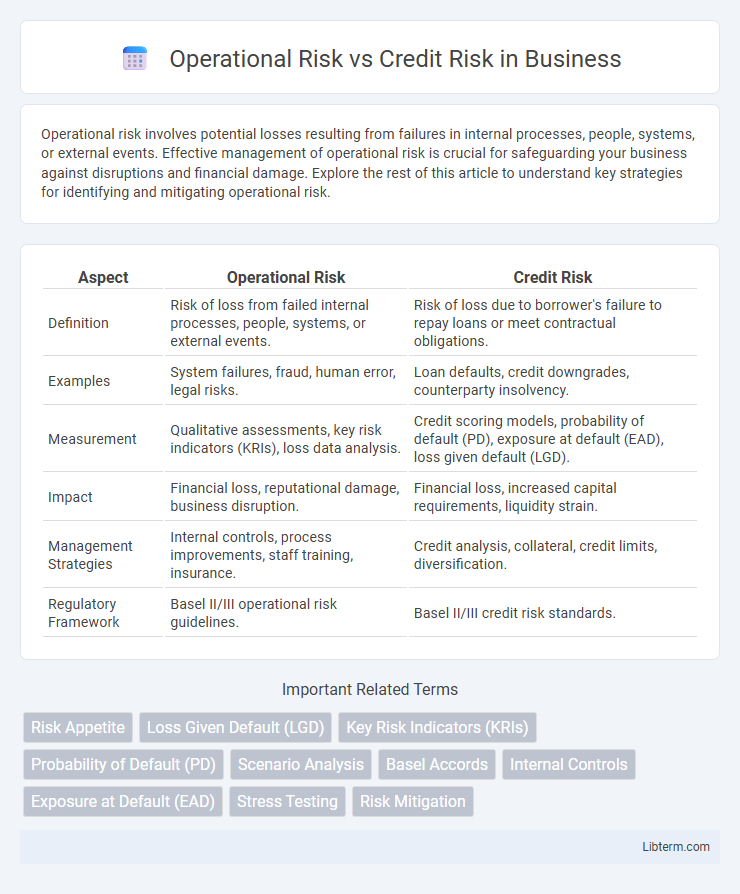Operational risk involves potential losses resulting from failures in internal processes, people, systems, or external events. Effective management of operational risk is crucial for safeguarding your business against disruptions and financial damage. Explore the rest of this article to understand key strategies for identifying and mitigating operational risk.
Table of Comparison
| Aspect | Operational Risk | Credit Risk |
|---|---|---|
| Definition | Risk of loss from failed internal processes, people, systems, or external events. | Risk of loss due to borrower's failure to repay loans or meet contractual obligations. |
| Examples | System failures, fraud, human error, legal risks. | Loan defaults, credit downgrades, counterparty insolvency. |
| Measurement | Qualitative assessments, key risk indicators (KRIs), loss data analysis. | Credit scoring models, probability of default (PD), exposure at default (EAD), loss given default (LGD). |
| Impact | Financial loss, reputational damage, business disruption. | Financial loss, increased capital requirements, liquidity strain. |
| Management Strategies | Internal controls, process improvements, staff training, insurance. | Credit analysis, collateral, credit limits, diversification. |
| Regulatory Framework | Basel II/III operational risk guidelines. | Basel II/III credit risk standards. |
Introduction to Operational Risk and Credit Risk
Operational risk involves potential losses from internal processes, human errors, system failures, or external events, distinct from credit risk which concerns the possibility of a counterparty failing to meet financial obligations. Credit risk primarily arises from borrower defaults, impacting banks' loan portfolios and investment securities. Understanding these risks is essential for effective risk management, capital allocation, and regulatory compliance within financial institutions.
Key Definitions: Operational Risk Explained
Operational risk refers to the potential for loss resulting from inadequate or failed internal processes, people, systems, or external events, distinct from credit risk which involves the possibility of borrower default. Key components of operational risk include fraud, system failures, human errors, and legal risks, emphasizing non-financial aspects impacting business continuity. Understanding operational risk is crucial for implementing effective risk management frameworks and regulatory compliance in financial institutions.
Key Definitions: Credit Risk Explained
Credit risk refers to the potential for financial loss arising from a borrower's failure to repay a loan or meet contractual obligations. It primarily involves the assessment of the borrower's creditworthiness and the likelihood of default. Unlike operational risk, which pertains to losses from internal failures or external events, credit risk centers on credit exposure and default probabilities in lending and investment portfolios.
Main Differences Between Operational Risk and Credit Risk
Operational risk involves losses from internal failures such as system breakdowns, human errors, or fraud, while credit risk pertains to the potential for financial loss due to a borrower's failure to repay a loan. Operational risk is primarily concerned with processes and controls within an organization, whereas credit risk focuses on counterparty creditworthiness and default probabilities. Quantifying operational risk often relies on loss event data and scenario analysis, whereas credit risk measurement depends on credit scoring models, credit ratings, and exposure at default metrics.
Sources and Causes of Operational Risk
Operational risk arises from internal processes, people, systems failures, and external events, such as fraud, human error, system outages, and natural disasters. Credit risk, by contrast, originates from borrowers' inability to repay loans or meet contractual obligations, primarily driven by economic conditions and borrower-specific factors. Effective risk management requires identifying operational risk sources like inadequate controls, process breakdowns, and cyber threats distinct from credit risk's focus on counterparty creditworthiness.
Sources and Causes of Credit Risk
Credit risk originates primarily from borrowers' failure to meet debt obligations due to factors including impaired cash flow, economic downturns, or poor credit management. Sources of credit risk encompass individual defaults, corporate insolvencies, and sovereign debt crises, often influenced by inadequate credit analysis and lending policies. Unlike operational risk, which stems from internal process failures or external events, credit risk directly relates to counterparty creditworthiness and repayment capacity.
Methods for Managing Operational Risk
Operational risk management employs methods such as risk identification, risk assessment, control implementation, and continuous monitoring to minimize losses from inadequate processes, systems, or human errors. Techniques like scenario analysis, key risk indicators (KRIs), and loss event databases enhance the detection and mitigation of operational risk exposures. These methods contrast with credit risk approaches that primarily focus on borrower creditworthiness, default probabilities, and collateral evaluation.
Methods for Managing Credit Risk
Methods for managing credit risk include credit scoring models that assess borrower creditworthiness using statistical analysis of historical data and financial ratios. Loan diversification strategies reduce exposure by spreading credit across various sectors, geographies, and borrower types, minimizing the impact of defaults. Credit derivatives such as credit default swaps (CDS) transfer risk to third parties, while stringent collateral requirements and regular credit monitoring enhance risk mitigation efforts.
Impact of Operational and Credit Risk on Financial Institutions
Operational risk, stemming from internal failures such as system breakdowns, fraud, or human errors, can lead to significant financial losses and damage to an institution's reputation, operational efficiency, and regulatory compliance. Credit risk, arising from borrowers' failure to meet debt obligations, directly impacts financial institutions through loan defaults, increased provisions, and potential capital erosion. Both risks critically affect liquidity, capital adequacy, and earnings stability, influencing overall financial health and stakeholder confidence.
Best Practices for Mitigating Both Risks
Implementing comprehensive risk assessment frameworks and continuous monitoring systems effectively mitigates both operational risk and credit risk by identifying potential vulnerabilities early. Leveraging advanced data analytics and machine learning models improves accuracy in predicting credit defaults and operational failures, facilitating proactive management. Establishing robust internal controls, clear governance structures, and rigorous employee training programs enhances the overall risk culture, minimizing exposure to financial losses and reputational damage.
Operational Risk Infographic

 libterm.com
libterm.com